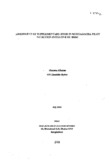Assessment of supplementary food in Muktagacha pilot nutrition initiative of BRAC
Citation
Khatun, M., & Hyder, S. Z. (1996, July). Assessment of supplementary food in Muktagacha pilot nutrition initiative of BRAC. Research Reports (1996): Health Studies, Vol - XlX, 250–272.Abstract
Food supplementation refers to providing additional food to the nutritional deprived
population in addition to their regular diet to reduce or meet the gap between intake and
requirement in order to improve their nutritional status. Since 1993 BRAC, through its
Women's Health and Development Program (W1IDP), has been operating a pilot Nutrition
Initiative in 158 villages of Muktagacha thana. The initiative used supplementary food as
the vehicle to communicating nutritional messages to the community in addition to
providing nutritional supplements to the target beneficiaries. This study was carried out to
determine the nutritional quality and the cost of the supplemental foods as wen as the
actual additional calorie consumption of the recipients from the food supplementation
project. Nutrient analysis of the foods was performed at the Institute of Nutrition and
Food Science (ThTFS), Dhaka University on 12 packets of supplemental foods which were
randomly selected. It was revealed from the cost calculation that the cost per packet of
adult and child food was Tk. 7.50 and 4.30 respectively. It was estimated that
supplementary food, if taken completely, could provide energy equivalent to 752 kcal to a
mother and 212 Kcal to a child under two years of age. However, mothers consumed
around 75% of the food which provided 564 Kcallday. It was obsetved that the food was
shared mostly with young children and husbands. In-depth interview ~ith mothers also
suggest that they usually skip breakfast if the food is given in the morning. The children
liked the food because of the taste and unless the child was sick or had some food before
coming to the center, he ate the food completely (212 Kcal/day). Although the main
purpose of the project was to provide nutrition education, it was observed that the activities
at the feeding center was limited to food distribution and had very little to do with
communication of nutritional messages. Therefore in the conclusion it was recommended
that the service providers should be trained to communicate nutritional messages effectively
as a part of understanding the goal of the initiative.

